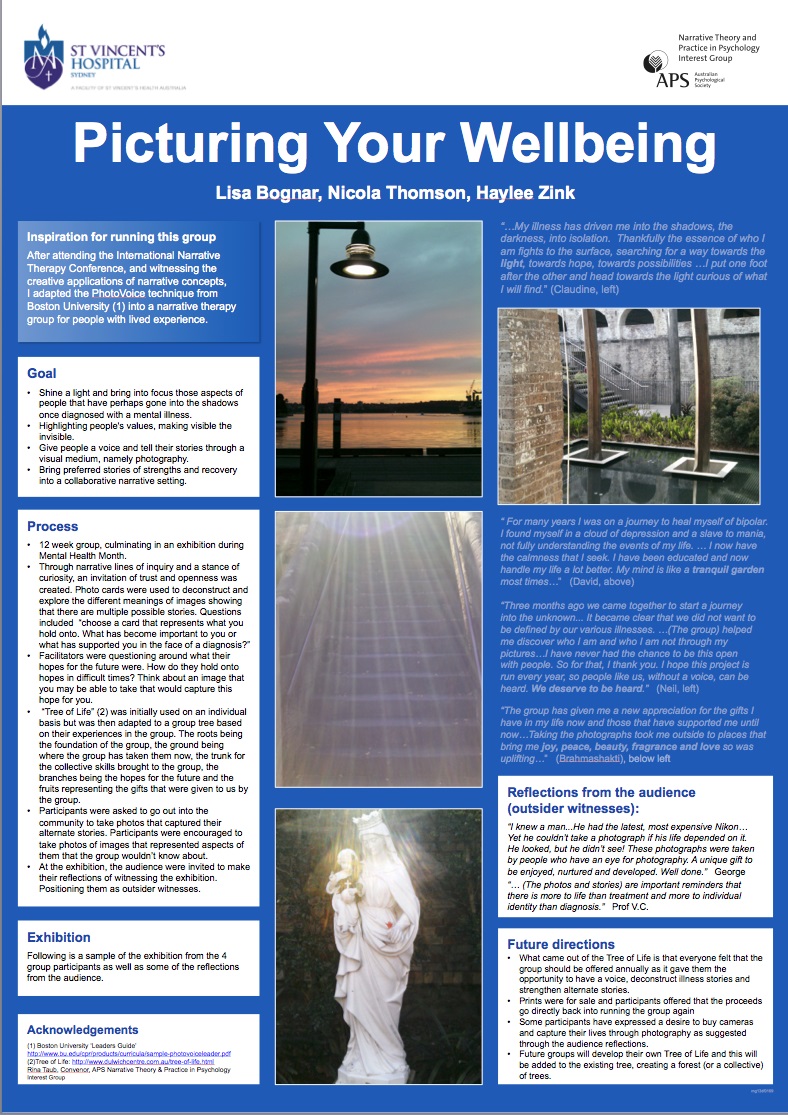Narrative Theory & Practice in Psychology
Picturing Your Wellbeing: A Therapeutic Photography Group
Lisa Bognar, Nicola Thomson & Haylee Zink
Background
The PhotoVoice concept was developed by Professor Caroline Wang at the University of Michigan School of Public Health and Mary Ann Burris from the Ford Foundation. It empowers marginalised people, whose voices frequently go unheard and whose perspectives often are overlooked to articulate and amplify their vision and experiences. PhotoVoice values the knowledge put forth by people living in a community, all with a particular health condition, as a vital source of expertise. By uniting the immediate impact of a photograph and the story that contextualises and enhances it, PhotoVoice enables us to gain “the possibility of perceiving the world from the viewpoint of the people who lead lives that are different from those traditionally in control of the means for imaging the world”.
Narrative therapy refers to the ideas and practices of Michael White and David Epston and other practitioners who have built upon this work. The narrative therapist is a collaborator with the client in the process of developing richer (or "thicker") narratives. In this process, narrative therapists ask questions to generate experientially vivid descriptions of life events that are not currently included in the plot of the problematic story. “The person is not the problem, the problem is the problem.” So-called strengths or positive attributes are also externalized, allowing people to engage in the construction and performance of preferred identities. Operationally, narrative therapy involves a process of deconstruction and "meaning making" which are achieved through questioning and collaboration with the client.
At St Vincent's Mental Health, we decided to adapt the PhotoVoice concept and apply narrative concepts to working with people with a diagnosis of mental illness. The intention behind facilitating this group was to shine a light and bring into focus those aspects of people that have perhaps gone into the shadows once diagnosed with a mental illness; to highlight people’s values, making visible the invisible.
Process
Referrals were open to all mental health consumers of the service that were interested in exploring alternate stories of mental illness and expressing themselves through a creative medium.
Through narrative lines of inquiry and a stance of curiosity, an invitation of trust and openness was created. Photo cards were used to deconstruct and explore the different meanings of images showing that there are multiple possible stories. Questions included “choose a card that represents what you hold onto. What has become important to you or what has supported you in the face of a diagnosis?”
Facilitators were questioning around what their hopes for the future were. How did they hold onto hopes in difficult times? They were encouraged to think about an image that could be taken that would capture this hope for them.
Participants were asked to go out into the community to take photos that captured their alternate stories. During group sessions, members were encouraged to create mind maps where they chose a word that represented recovery to them and extrapolated this word to words that they could then capture in an image. Participants were encouraged to take photos that represented aspects of them that the group wouldn’t know about.
The 12-week group culminated in a week long exhibition, which coincided with Mental Health Month. Each participant chose to exhibit a series of the images, their accompanying narratives as well as a reflection of their experiences in the group. The participants were given the opportunity to invite significant people to a private launch which was then followed by the public launch. Guests of the exhibition were invited to write their reflections in a book and notice how the exhibition impacted on them. Following is a sample of the exhibition.
Exhibition
|
|
“…My illness has driven me into the shadows, the darkness, into isolation. Thankfully the essence of who I am fights to the surface, searching for a way towards the light, towards hope, towards possibilities …I put one foot after the other and head towards the light curious of what I will find.” (Claudine)
|
|
“ For many years I was on a journey to heal myself of bipolar. I found myself in a cloud of depression and a slave to mania, not fully understanding the events of my life. … I now have the calmness that I seek. I have been educated and now handle my life a lot better. My mind is like a tranquil garden most times…” (David) |
|
|
|
“Three months ago we came together to start a journey into the unknown... It became clear that we did not want to be defined by our various illnesses. …(The group) helped me discover who I am and who I am not through my pictures…I have never had the chance to be this open with people. So for that, I thank you. I hope this project is run every year, so people like us, without a voice, can be heard. We deserve to be heard.” (Neil)
|
|
|
“The group has given me a new appreciation for the gifts I have in my life now and those that have supported me until now…Taking the photographs took me outside to places that bring me joy, peace, beauty, fragrance and love so was uplifting…” (Brahmashakti)
|
|
|
Reflections from the facilitators
The trust and openness that was displayed by the participants was greatly appreciated. We were all curious to uncover each individual’s values and resources that they were utilising to stand in the face of their illness. These were shared amongst the group and became valued by other members.
We all reflected on how energising the group was to be involved in, both because of the investment by the participants but also the creativity that was nurtured. There was great excitement about the exhibition and it was truly a group experience in putting it together.
We all learnt from each other and valued the space that was created enabling participants to be truly heard.
Reflections from the audience (outsider witnesses)
In true Narrative style, insider witnesses are invited to reflect on how the exhibition had impacted on them and this in turn is reflected back to the participants.
“I knew a man, many years ago. He had the latest, most expensive, top of the range Nikon. The camera of its day. Yet he couldn’t take a photograph if his life depended on it. He looked, but he didn’t see! These photographs were taken by people who have an eye for photography. A unique gift to be enjoyed, nurtured and developed. Well done.” George
“Thank you so much for this stunning and deeply moving exhibition. Your courage and bravery is truly inspiring and admirable. This project is so necessary! Thank you for sharing your perspective through so many beautiful photographs. I can’t wait to see this exhibition next year... I can only imagine just how profound this experience must have been! I hope that you are able to share more photographs and stories with more people in the future.” Liesel
“They are terrific – all have a great sense of thoughtfulness, wisdom and acceptance. I hope this will continue to grow and thrive as a project and that the participants do too. Nice to see local places interpreted.“ Prof K.W
“Congratulations to everyone involved in this project and praise to those whose pictorial stories are portrayed so movingly. They are important reminders that there is more to life than treatment and more to individual identity than diagnosis.” Prof V.C
Future directions
· The Tree of Life highlighted that both group members and facilitators would like to see the group offered annually, particularly as it gave people an opportunity to have a voice, deconstruct illness stories and strengthen alternate stories.
· Images were for sale and participants offered that the proceeds go directly back into running the group again
· Some participants have expressed a desire to buy cameras and capture their lives through photography as inspired by the group but also as suggested through the audience reflections.
· Future groups will develop their own ‘Tree of Life’ and this will be added to the existing tree, gradually creating a forest (or a collective) of trees.
We welcome any feedback about your thoughts on the group. The facilitators can be contacted by email:
|
Lisa Bognar |
Nicola Thomson |
Haylee Zink |
If you would like to give your reflection on this work to the participants, we will attempt to share it with them.

[i] Boston University ‘Leaders Guide’ http://www.bu.edu/cpr/products/curricula/sample-photovoiceleader.pdf
Tree of Life: http://www.dulwichcentre.com.au/tree-of-life.html








